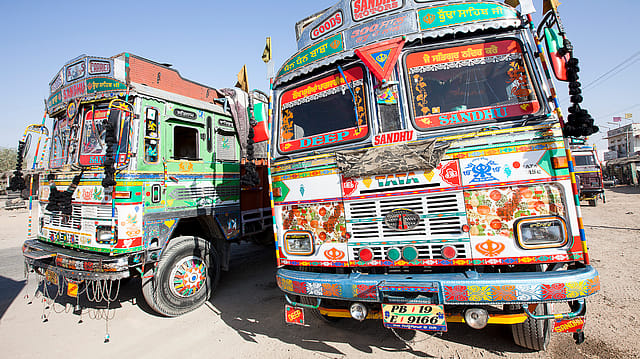India's AC cabin mandate to disrupt cowl truck market
ADVERTISEMENT

The government's plan to make air-conditioned cabins mandatory in trucks is set to disrupt the medium and heavy commercial vehicles market as half of the long-haul trucks currently sold in the country come without cabins.
India's heavy-duty haulage truck market is dominated by cowl trucks — lorries without factory-fitted cabins — which are fabricated at unorganised bodybuilding workshops.
The Centre's mandate on AC-fitted cabins in all new trucks manufactured on or after October 1, 2025 aims to offer comfort to truck drivers in India's scorching summers. The regulation is also the first among a series of proposals that seek to enhance the safety of trucks.
Around 50% of medium and heavy commercial vehicle haulage trucks in the country are sold in cowl-chassis form, says Jalaj Gupta, business head – commercial vehicles unit, Mahindra & Mahindra. Tippers and trailers have already migrated to OEM-fitted cabins, Gupta says. The automaker sells almost all of its trucks with company-made cabins, 30% of which come with built-in ACs.
India's largest truckmaker Tata Motors and Ashok Leyland are among the leading manufacturers of cowl trucks. Both declined to comment on the share of cowl trucks in their portfolio.
"We currently offer AC cabins as an option and will comfortably comply with the mandate to offer it across our entire range of trucks well within the deadline... While there is a marginal increment in costs, the overall benefits for both customers and drivers are significantly higher," a Tata Motors spokesperson said.
January 2026
Netflix, which has been in India for a decade, has successfully struck a balance between high-class premium content and pricing that attracts a range of customers. Find out how the U.S. streaming giant evolved in India, plus an exclusive interview with CEO Ted Sarandos. Also read about the Best Investments for 2026, and how rising growth and easing inflation will come in handy for finance minister Nirmala Sitharaman as she prepares Budget 2026.
Fleet operators who still run their business with cowl trucks will certainly feel the pinch, according to Satyakam Arya, managing director and CEO of Daimler India Commercial Vehicles. "But, those who have transitioned to trucks with air-conditioned cabins will know the difference in the performance of their drivers and consequently the business improvement," he says.
Around 60% of BharatBenz trucks sold in India have air-conditioned cabins. When the German automaker rolled out its first truck in India in 2012, the marketplace mostly consisted of unsafe cowl trucks with mounted wooden cabins. "The notion then was that a wooden cabin insulated the driver from the heat while trucks with air-conditioned cabins made the truck heavier and delivered lower fuel efficiency, which was yet another myth," Arya explains.
Of late, there has been a lot of awareness on why a factory-fitted metal cabin is much safer for the driver, Arya says. "Air-conditioning reduces driver fatigue and their job satisfaction goes up. This improves their driving capability and reduces cargo turnaround time leading to much better overall fleet performance," he says.
While most automakers have welcomed the government's latest move, there is still ambiguity on whether the new regulation would be the end of the road for unsafe cowl trucks.
Mahindra's Gupta doesn't expect the new mandate to end the cowl truck business. "New AC mandate is to supply cowl chassis with AC kit by OEM. This means cowl sales will continue and bodybuilders will be fitting AC," he says.
Driving in comfort
Air-conditioned cabins are expected to offer a comfortable ride to drivers who spend long hours on the road and reduce turnaround time.
Drivers may be able to drive for longer periods with less fatigue, potentially improving operational efficiency, says Harshvardhan Sharma, head, auto retail practice, Nomura Consulting.
Driver fatigue is one of the major causes of road accidents and AC cabins could contribute to a reduction in accidents by keeping drivers alert, Sharma says.
Agrees, Daimler's Arya, who believes AC cabins can bring down the accident rate dramatically. AC cabins can also reduce hearing impairment among drivers, who develop aural problems, especially in the right ear, due to continuous and prolonged exposure to high decibels of traffic noise coming through the open windows, Arya explains.
However, the new regulation is expected to raise upfront costs for truck buyers. Implementing air-conditioned cabins may result in some additional costs, with estimates ranging from ₹30,000 to ₹50,000, depending on the vehicle size, says Vinod Aggarwal, managing director and CEO, VE Commercial Vehicles Limited (VECV). "In some models, particularly light commercial vehicles, OEMs may need to consider drivetrain changes and increased engine power to accommodate AC cabins," Aggarwal adds.
According to Kinjal Shah, vice-president and co-group head at ICRA, the price impact due to the AC-fitted cabin would be somewhere between ₹40,000 and ₹60,000 which would mean around 2-3% increase in cost on the average truck price of ₹20 lakh.
Running costs such as fuel and maintenance are also likely to rise. "AC systems can reduce fuel efficiency by 2-4%. This could offset some of the financial benefits of increased driver productivity," says Nomura's Sharma. AC systems require regular maintenance which can add to operating costs, he adds.
While there will be some initial costs and challenges, the benefits in terms of driver well-being, safety, and productivity are likely to outweigh the downsides, says Sharma.
